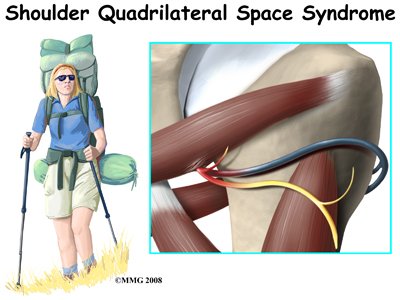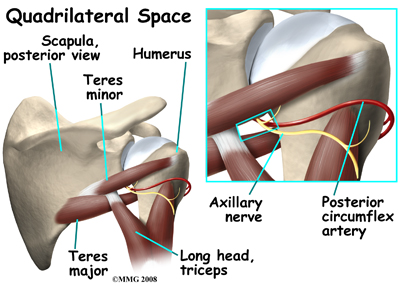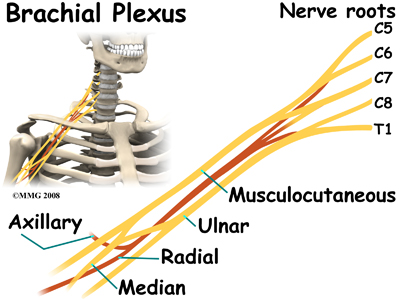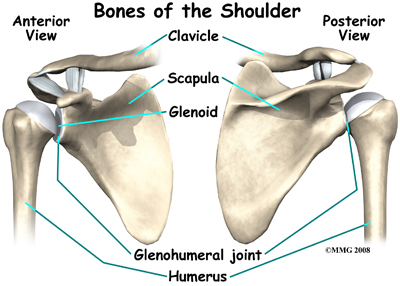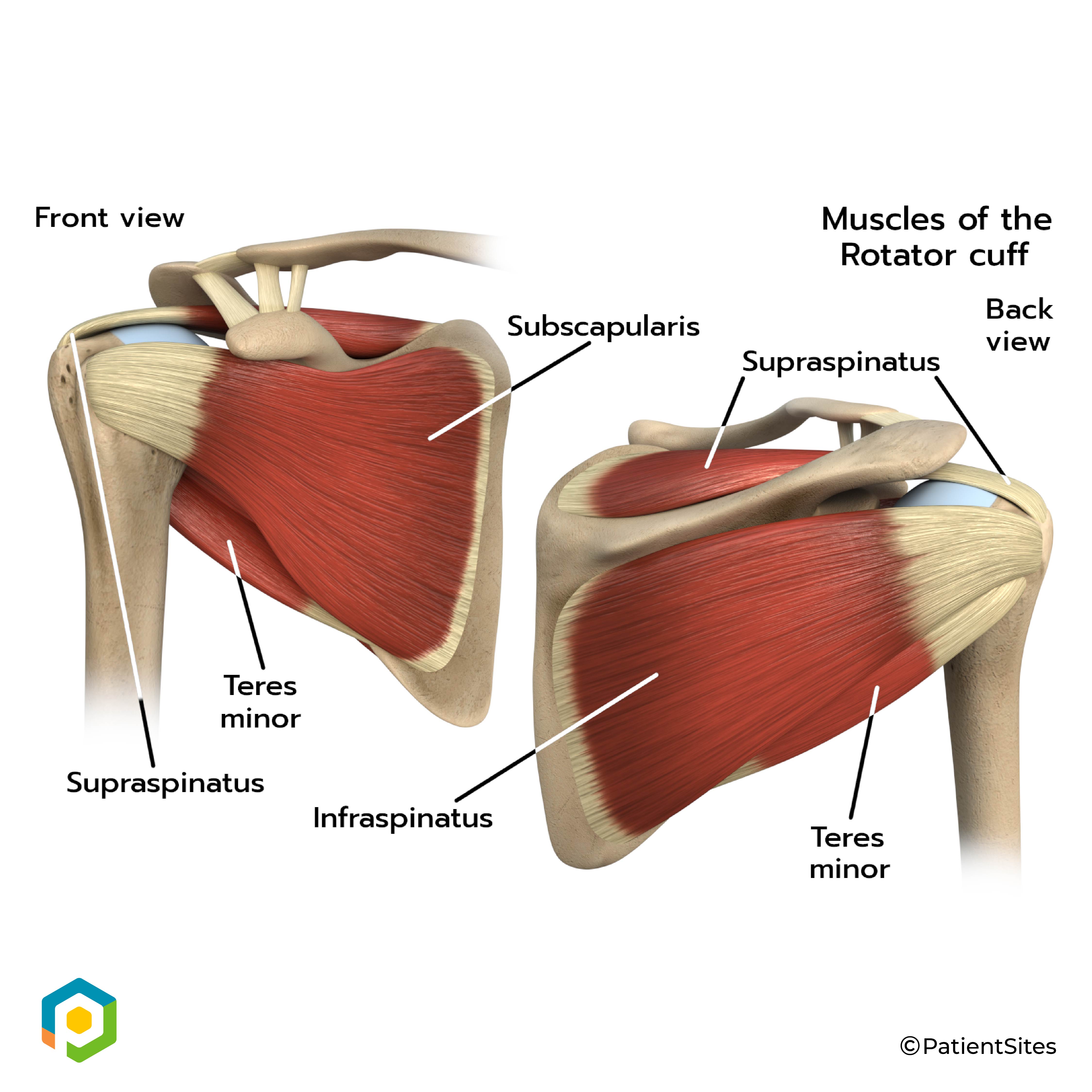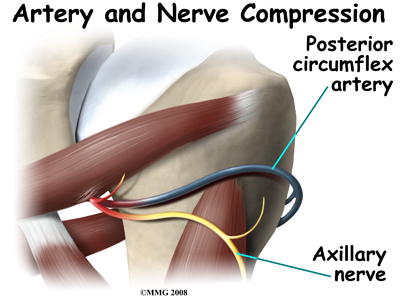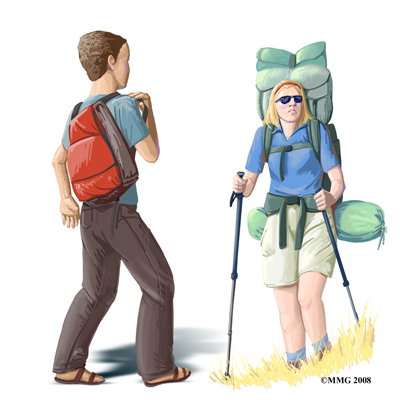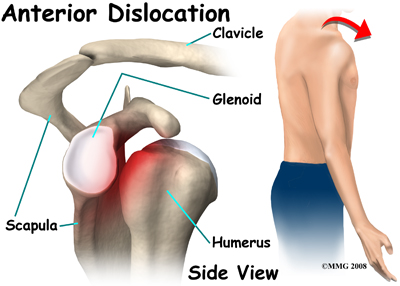Introduction
Physiotherapy in Bathurst for Shoulder
Welcome to Physio Max's patient resource about quadrilateral space syndrome.
Quadrilateral space syndrome (QSS) happens when the axillary nerve is compressed, or injured in the back of the shoulder. Sometimes the symptoms are caused by the compression of an artery in the same area.
Quadrilateral space syndrome usually happens from overuse, especially with overhead sports like throwing and swimming. The syndrome can also be caused by an injury, like a shoulder dislocation.
This guide will help you understand:
- what parts of the shoulder are involved
- what causes this condition
- how the condition is diagnosed
- what treatment options are available
#testimonialslist|kind:all|display:slider|orderby:type|filter_utags_names:Shoulder Pain|limit:15|heading:Hear from some of our patients who we treated for *Shoulder Pain*#
Anatomy
What parts of the shoulder are involved?
A quadrilateral is a four-sided shape. The quadrilateral space of the shoulder is in the upper back, where the shoulder meets the body. Three of the sides of the quadrilateral space are formed by muscles. The top of the quadrilateral is bordered by a muscle called the teres minor. The teres major muscle forms the bottom border. Part of the triceps muscle forms the inside border. The long bone of the upper arm, called the humerus, makes up the outer border.
In addition to these muscles, the axillary nerve and the posterior circumflex humeral artery are in the quadrilateral space. When either the nerve or the artery is compressed or injured in this area it can cause problems such as quadrilateral space syndrome.
The axillary nerve is considered a peripheral nerve. There are several peripheral nerves in the shoulder that can be injured. The spinal cord in the neck, or cervical area, has branches that are called:
Nerve Roots
The nerve roots in the neck come together to form a large peripheral nerve called the brachial plexus. The axillary nerve is one of the branches off the brachial plexus. The axillary nerve is mainly formed from the fifth (C5) and sixth (C6) cervical nerve roots. The axillary nerve gives strength to the teres minor muscle and the deltoid muscle. It gives sensation to the shoulder joint.
The shoulder joint is also known as the:
Glenohumeral Joint
It is a ball and socket joint. The glenoid is the cup portion of the shoulder joint. The upper end of the humerus forms the ball portion.
The shoulder joint is supported by many muscles. The most famous are the four rotator cuff muscles. They combine at the shoulder to form a thick cuff. They are also referred to as the SITS muscles. Each letter stands for one of the rotator cuff muscles; supraspinatus, infraspinatus, teres minor, and subscapularis. Sometimes injury to the quadrilateral space is mistaken as rotator cuff injury.
Related Document: Physio Max's Guide to Shoulder Anatomy
Shoulder Anatomy Introduction
Causes
What causes this condition?
Repetitive stress or overuse is a major cause of quadrilateral space syndrome. Some of the more common causes of overuse are seen in overhead sports like throwing and swimming. Children specializing in certain sports at early ages, have increased risk of getting quadrilateral space syndrome. Sometimes poor training techniques are to blame. Bands of extra fibers are usually what cause the compression of the axillary nerve, or the small artery in the quadrilateral space.
There are varying degrees of nerve injury. Most commonly, injury to the axillary nerve is a more mild form of injury called neuropraxia. This means that it typically recovers fully. The axillary nerve is very short, so even a severe injury can heal rather quickly.
An acute axillary nerve injury can also happen from carrying a heavy backpack. The misuse of crutches can also cause compression of the nerve.
The most common traumatic injury that causes quadrilateral space syndrome (QSS) is a:
Should Dislocation
Some reports show that quadrilateral space syndrome can happen 10 to 60 percent of the time after a shoulder dislocation. There is a greater risk depending on the type of dislocation. A blunt force injury to the back of the shoulder can also cause quadrilateral space syndrome.
Symptoms
What does quadrilateral space syndrome feel like?
Symptoms of quadrilateral space syndrome usually include vague shoulder pain, numbness or tingling in the arm, and tenderness to pressure over the area of the quadrilateral space.
A dull ache in the shoulder may worsen when the arm is moved overhead repeatedly.
Weakness and instability can sometimes be noted.
The diagnosis of quadrilateral space syndrome is often missed since symptoms can be similar to other shoulder problems.
Diagnosis
Following an assessment your physiotherapist at Physio Max will advise you of the findings and create an individualized physiotherapy program.
He or she may request additional testing to help define the true nature of your injury. Below is a guideline of what you might expect during rehabilitation for your injury.
Our physiotherapist will ask questions about your activity, possible traumatic injury, and the symptoms you are having. Physical examination usually includes evaluating range of motion, strength testing, checking reflexes and assessing sensation. During this examination we will appy pressure over various areas of the shoulder to see where it may be painful.
Weakness and instability are common symptoms. The diagnosis of quadrilateral space syndrome is easy to miss since symptoms can be similar to other shoulder problems. Often there will be wasting of specific muscles supplied by the axillary nerve such as deltoid or teres minor. Subluxation (instability) of the glenohumeral joint is a significant symptom to be assessed with this syndrome.
Some Physio Max patients may be referred to a doctor for further medical evaluation.
Our Treatment
Non-surgical Rehabilitation
Most of the time, quadrilateral space syndrome will improve with nonsurgical treatment.
There are varying degrees of nerve injury. Most commonly, injury to the axillary nerve is a more mild form of an injury called neuropraxia. This means that it typically recovers fully. The axillary nerve is very short, so even a severe injury can heal rather quickly.
It is important to rest your shoulder, and your physiotherapist at Physio Max may suggest taking a break from the activity that may be causing your symptoms. Changing throwing or sport mechanics may be helpful.
We may also recommend over-the-counter anti-inflammatories (NSAIDs) such as ibuprofen. Heat or cold packs to your shoulder can also be beneficial.
Physio Max will help you to maintain shoulder range of motion, or flexibility. Posture training may also be helpful. Our physiotherapist may have you change the way you do your overhead sport when overuse is a possible cause.
Electrical muscle stimulation (EMS) may be beneficial when there is muscle weakness or wasting. EMS is a battery operated device that sends electrical current to your muscles to make them contract. This will help maintain strength and decrease wasting of the muscle. There are units that can be used at home.
Although the time required for recovery varies, after about four weeks, many patients are able to do more exercise on their own. Usually by six weeks, exercises specific to your sport are introduced into your physiotherapy program. In most cases, you can expect to have full range of motion, and be able to resume activity in 12 weeks.
Time required for return to sports varies. Repeat EMG studies are often ordered by your physician to see if the axillary nerve is improving. Improvement in the EMG should be seen, and near full recovery of deltoid muscle strength is recommended before return to your activity or sport. Sport specific retraining may be necessary before you can play your sport at full intensity.
Most of the time, conservative care such as physiotherapy is all that is needed. Rarely is surgery needed.
Post-surgical Rehabilitation
Most post-surgical shoulder rehabilitation includes three phases.
Phase I goals are to limit pain, and allow range of motion at the shoulder. When you begin your Physio Max post-surgical rehabilitation, we will start with gentle shoulder mobility to keep scar tissue from forming again. This also keeps the nerve and blood vessels moving freely. During the first four weeks after surgery, it is important not to overuse your arm. Our physiotherapist may also have you work on posture as part of your physiotherapy.
Phase II includes gentle strengthening of the shoulder and upper extremity. Total body conditioning is also important. Our physiotherapist may recommend that you ride a bike, walk on a treadmill, and strengthen the core muscles in your trunk.
Phase III is usually started six weeks after surgery, although the time required for surgery varies among patients. This includes sport specific activities, functional activities, and continued conditioning. Your physiotherapist may have you change the way you do your overhead sport when overuse has been the problem.
Your surgeon may suggest that you have the EMG repeated at monthly intervals to see if the axillary nerve is improving, especially after surgery to graft the nerve. By twelve weeks, you should have full range of motion of the shoulder with good pain control. As in non-surgical rehabilitation, time required for return to sports varies. In general, it is recommended there be improvement in the EMG, and that the muscle strength of the operated shoulder is at least 80 percent of the muscle strength of nonoperated shoulder.
At Physio Max, our goal is to help you keep your pain under control, improve range of motion, and maximize strength and control in your shoulder. When your recovery is well under way, regular visits to our office will end. Although we will continue to be a resource, you will be in charge of doing your exercises as part of an ongoing home program.
Physio Max provides services for physiotherapy in Bathurst.
Surgery
For some patients, surgery may be required.
Bands of extra fibers in the quadrilateral space are usually what cause the compression of the axillary nerve or the small artery or vein. These bands of fibers are clipped or removed during surgery. This type of surgery is called decompression. It is quite effective.
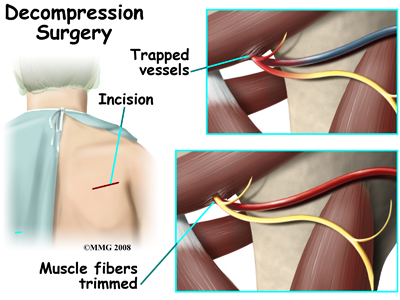
Occasionally, after high-energy trauma, or during surgery, the axillary nerve will be over-stretched, or even cut. This type of injury is called neurotomesis. The axillary nerve may need to be repaired. The injured portion is replaced with another nerve. This is called a nerve graft.
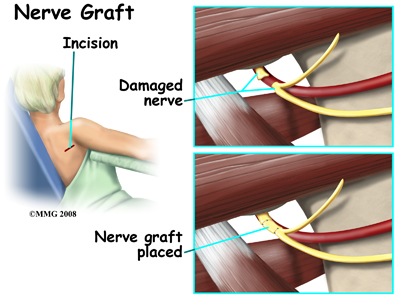
Your surgeon will operate from the back of the shoulder, making a small incision. In the case of nerve grafting, there will be a small incision where the other portion of nerve is removed. You will be allowed to go home the same day. Your arm will likely be in a sling.
Portions of this document copyright MMG, LLC.







